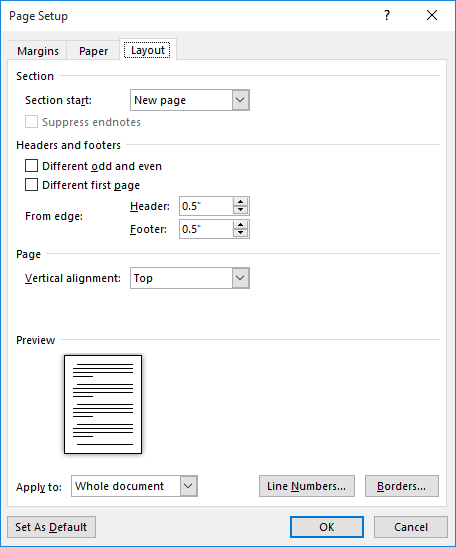Please Note: This article is written for users of the following Microsoft Word versions: 2007, 2010, 2013, 2016, 2019, and 2021. If you are using an earlier version (Word 2003 or earlier), this tip may not work for you. For a version of this tip written specifically for earlier versions of Word, click here: Odd & Even Headers and Footers.
Written by Allen Wyatt (last updated May 9, 2020)
This tip applies to Word 2007, 2010, 2013, 2016, 2019, and 2021
As you have learned in other WordTips, Word allows you to easily add headers and footers to your document. You can also specify that different headers and footers be used for both odd and even pages. Word will then automatically determine which footer is the proper one to use for the given page. To define separate odd and even headers or footers, do the following:

Figure 1. The Layout tab of the Page Setup dialog box.
Now you can set the headers and footers:
WordTips is your source for cost-effective Microsoft Word training. (Microsoft Word is the most popular word processing software in the world.) This tip (9803) applies to Microsoft Word 2007, 2010, 2013, 2016, 2019, and 2021. You can find a version of this tip for the older menu interface of Word here: Odd & Even Headers and Footers.

Comprehensive VBA Guide Visual Basic for Applications (VBA) is the language used for writing macros in all Office programs. This complete guide shows both professionals and novices how to master VBA in order to customize the entire Office suite for their needs. Check out Mastering VBA for Office 2010 today!
If you don't want the information in a header or footer to be changed by users of your document, there are a couple of ...
Discover MoreEditing what is in your page header or footer is fairly easy, and you can use the same editing techniques you already ...
Discover MoreNeed to get headers and footers from one document to another? You can use the steps in this tip to help make quick work ...
Discover MoreFREE SERVICE: Get tips like this every week in WordTips, a free productivity newsletter. Enter your address and click "Subscribe."
There are currently no comments for this tip. (Be the first to leave your comment—just use the simple form above!)
Got a version of Word that uses the ribbon interface (Word 2007 or later)? This site is for you! If you use an earlier version of Word, visit our WordTips site focusing on the menu interface.
Visit the WordTips channel on YouTube
FREE SERVICE: Get tips like this every week in WordTips, a free productivity newsletter. Enter your address and click "Subscribe."
Copyright © 2025 Sharon Parq Associates, Inc.
Comments